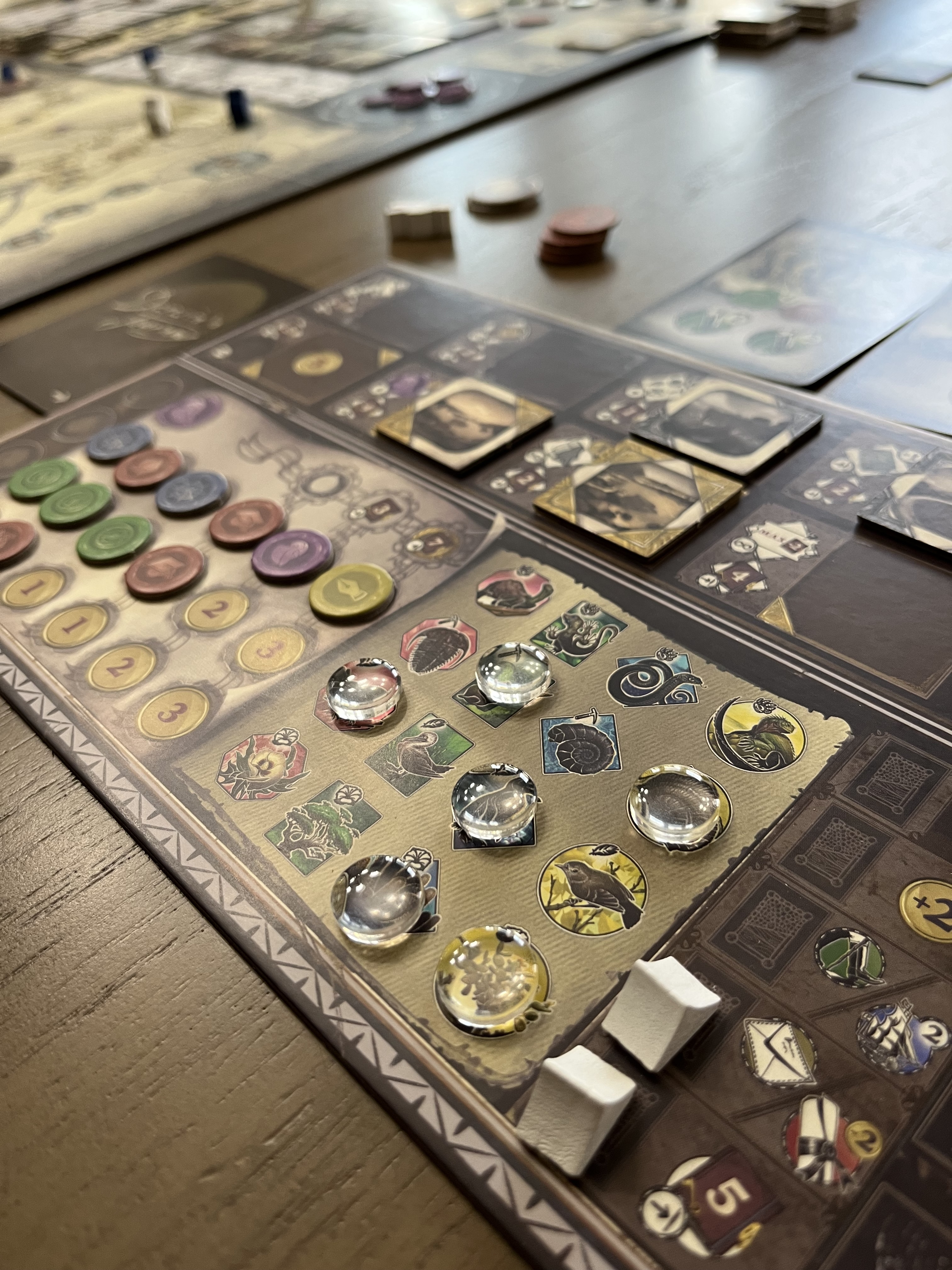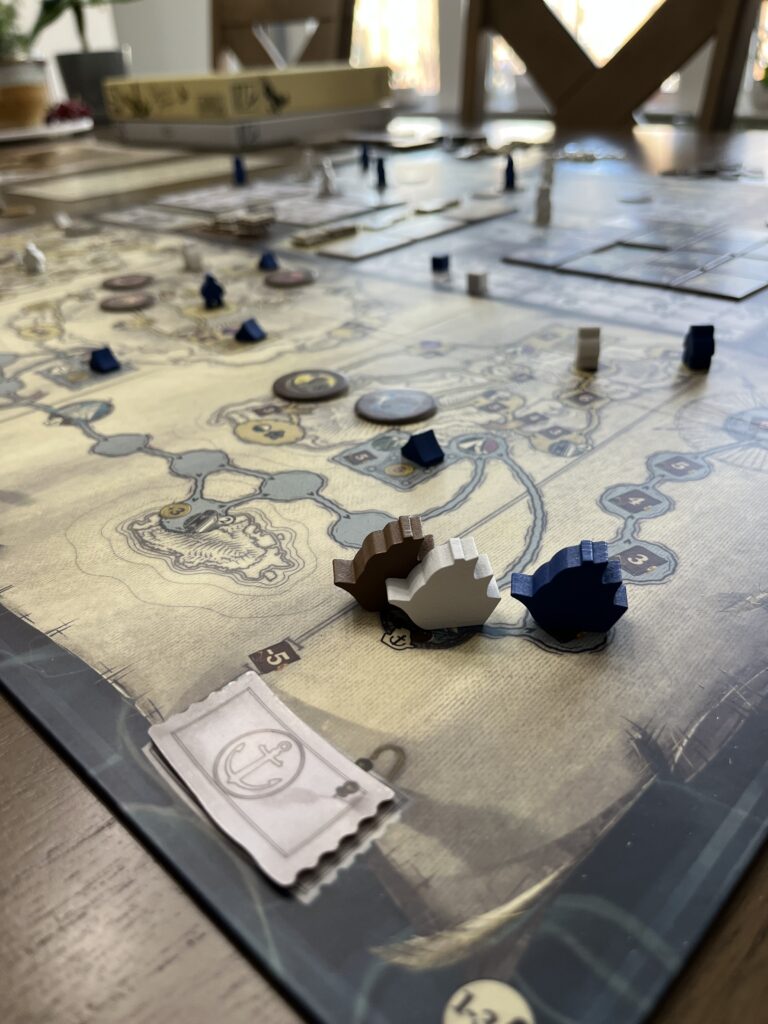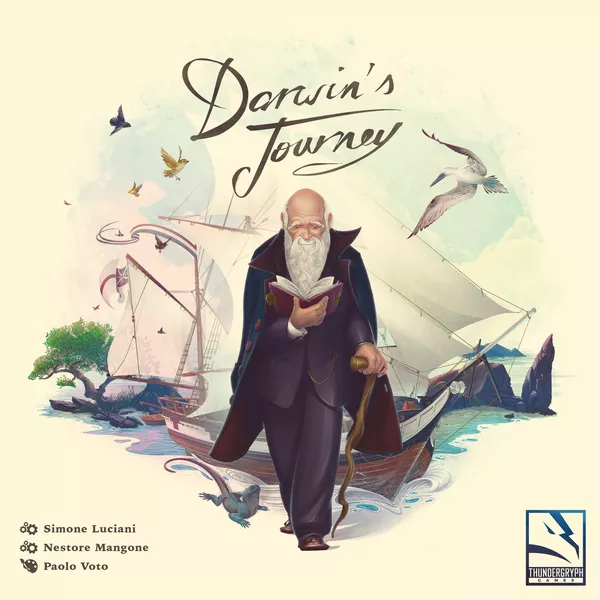Welcome to this week’s review! This week I’m discussing a game that has been on my radar for quite some time now. So without further ado, let’s jump into it!
Darwin’s Journey
- Designers: Simone Luciani, Nestore Mangone
- Publisher: ThunderGryph Games
- Complexity: Heavy
- Time: 60-120 Minutes
- Players: 1-4
- Main Mechanisms: Worker Placement
Darwin’s Journey is one of latest games from designer Simone Luciani. I’ve generally enjoyed Luciani’s designs – both Lorenzo il Magnifico and Nucleum made it into my Top 40 Games of All Time.
Darwin’s Journey is themed around Charles Darwin’s adventure through the Galapagos Islands. In the game, players will take turns placing their workers onto action spaces to take the associated action; however, some action spaces have requirements that the worker must satisfy before they can be placed.

This leads me into my favorite part of the game which is the innovative worker progression system. I mentioned that some action spaces have requirements that the worker must satisfy, and this is done through different colored seals that you assign to your workers. One of the core actions allows players to purchase additional seals from the display, which are then permanently added to that worker for the rest of the game. In the base game, there are four different colored seals, each corresponding to one of four different types of actions, as well as a wild purple seal that can operate as any one of the colored seals.
As the game progresses, players also have the option of unlocking more worker-placement spots, which will often require a worker to have either multiple of one type of seal or a mix of two in order for a worker to be placed on them. If you followed my Top 40 Games of All Time series, you may have noticed that I really enjoy games that provide a sense of progression throughout the game, often through unlocking more actions. For example, a couple of my favorites include Caverna and Great Western Trail. In Darwin’s Journey, actions towards the beginning of the game can feel very tight and limiting, but if you unlock more actions throughout the game, you’ll be accomplishing a lot more with your workers by the last couple of rounds.
Another interesting mechanism is the way newly unlocked actions operate. When a player unlocks an action for the first time, they will place one of their lens tokens on the spot and then immediately get to carry out the associated action. By unlocking the action, that action is now available to all players; however, if another player uses that action space, the player who unlocked it receives an extra coin. While it can sometimes feel frustrating when another player takes the action spot you unlocked, it creates a sense of a shared board, while also still rewarding the player who initially unlocked the action. Since the action to unlock new actions is a separate worker placement spot, I found myself occasionally unlocking actions that I wouldn’t be able to take advantage of right away because I lacked the required seals, but rather to carry out that action right away.
I mentioned that there are four colored seals corresponding to one of the four different types of main actions. However, in each game, there are six additional special action tiles that are randomly chosen during setup. These actions are often variations of other actions throughout the game, and I found that they allowed for multiple different strategies and paths to victory to pursue. This combined with the correspondence tiles (which provide end-of-round benefits), crew cards, objectives, and beagle goal tiles (end-of-round scoring) lead to a lot of replay value.
Another positive is that considering the complex gameplay with a lot of moving parts, it still feels very smooth. The game plays out over five rounds, and in each round, you’ll either place four or five workers. And outside of maybe a few special actions, the actions themselves are pretty straightforward and quick to resolve. So while there was a fair amount of rules upfront, once we got going, I was able to play a two-player game in just a bit over an hour. While some box covers may disagree, I find that playing a heavy euro in around an hour to be a rarity. If you’re a fan of Simone Luciani’s games, you should have no problem learning this one.
Having played a few of Luciani’s designs, one easy comparison is through one mechanism found in Lorenzo. In Lorenzo, if you want to take a card from a tower that already has a worker on it, then you have to pay additional coins to take that action. Luciani takes that mechanism and applies it similarly to Darwin’s Journey. In Darwin’s Journey, the main actions are separated into different sections that are referred to in the game as diaries. If you want to play a worker in a diary that already has a worker – you guessed it – you have to pay additional coins to do so. While I appreciate how the mechanism encourages players to differentiate from one another, I can’t help but think about how another recent game I reviewed, SETI: Search for Extraterrestrial Intelligence, applies a slightly different mechanism to encourage diversification. In SETI, there are twelve different tiles that can be researched, and all players can research each one. However, the first person to research a specific tile gets an extra two points.
This leads me to my biggest critique of Darwin’s Journey – which is that the game can feel overly tight at times. In particular, money can be extremely difficult to come by, especially if none of the end-of-round bonuses provide any (drawn by luck). There were times when both my wife and I felt stuck because we didn’t have enough coins to take the action we wanted and there wasn’t a great way to get more. Again, I can understand why there are built-in penalties for taking similar actions to that of another player, but I can’t help but wonder if there could have been a way to encourage diversification other than by tightening the game.
Another slight negative is that the objective tiles can be difficult to plan for, and they remind me of those in Nucleum. In Nucleum, there are a facedown stack of objective tiles with a few face up in a display. Any player can take any of the displayed ones and fulfill it at almost any time, even during the same turn they take the tile. Since there are only so many objectives available at any one time and it’s somewhat random which new ones come out, one player could get lucky and draw an objective they could immediately fulfill without any prior planning. In Darwin’s Journey, the objective tiles work similarly, except that only two basic and two advanced objectives are available during each round. Again, since there is limited knowledge to when objectives come out, this can lead to a feeling of randomness that I didn’t necessarily enjoy in a game without much of it.
Finally, while the game is themed around Charles Darwin’s journey through the Galapagos, I found that delivering specimens to the museum to be a bit less exciting than other parts of the game. The main way that players can collect specimens is by moving their explorers around the different islands, as well as through their ship token. When either one of these lands on a specimen location, the player collects the associated specimen. Using a separate action, players can deliver these specimen to the museum, which involves earning coins, as well as moving their evolution marker forward along a track that provides points at the end of the game based on how far up the track you’ve progressed, as well as how many specimen have been delivered. While there’s nothing necessarily wrong about this mechanism, I just felt that the process was less exciting when compared to other parts of the game, especially considering the game’s theme.

This is already one of my longer reviews I written, and I still feel like I’ve barely scratched the surface of all the different elements in Darwin’s Journey. While the game can feel a bit tight and punishing at times, the innovative worker progression system combined with unlocking more actions is what kept me wanting to come back to the game again and again. It also helps that the gameplay feels very smooth, and my wife and I were able to finish games relatively quickly. I know I mentioned a few negatives from my experience, but that still doesn’t hold Darwin’s Journey back from becoming a new favorite of mine. We’ll have to see where the game lands when I do my next round of rankings, but it’s definitely in the running for my favorite Simone Luciani game.
With that, I’ll wrap up this week’s review! I’d love to hear your thoughts on any of the games I’ve mentioned, future content, or format in the comments section below. Happy gaming!
If you liked this post and want to be notified when new content is released, then follow me on Instagram @themeepledigest.
